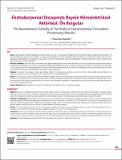DSpace Repository
The Neuroelectric Activity of The Brain in Extracorporeal Circulation: Preliminary Results
- DSpace Home
- →
- Web Of Science
- →
- Web Of Science
- →
- View Item
JavaScript is disabled for your browser. Some features of this site may not work without it.
| dc.contributor.author | Bayazıt, Turan Onur
|
|
| dc.date.accessioned | 2024-03-25T06:46:32Z | |
| dc.date.available | 2024-03-25T06:46:32Z | |
| dc.date.issued | 2018 | |
| dc.identifier.issn | 1305-9319 | |
| dc.identifier.issn | 1305-9327 | |
| dc.identifier.uri | http://hdl.handle.net/11547/11401 | |
| dc.description.abstract | Objective: The use of a cardiopulmonary machine during cardiac surgery causes a non-physiological circulation in the brain and the other body organs. This situation usually causes brain ischemia. Due to this or other factors, neurological disorders such as stroke and psychiatric disorders are encountered during the perioperative period. In this study, it was aimed to compare neuroelectrical activity measured during extracorporeal circulation in coronary bypass surgery with preoperative values of the patient. Materials and Methods: Six male patients who underwent coronary artery bypass surgery in cardiovascular surgery participated in the study. Both the preoperative (Pr0) and during operation (In0) electroencephalography (EEG) data obtained from the frontal region. The data (delta; 0.5-3.5 Hz), theta (theta; 3.5-7 Hz), alpha (alpha; 8-14 Hz), beta (beta;15-30 Hz) ve gamma (gamma; 30-48 Hz) frequency power components were calculated. An equal number of Pr0 and In0 period EEG power values from each participant were taken and used for statistical analysis. Results with a p-value of Less than 0.05 were considered statistically significant. Results: The main finding of the study is that the frequency power spectrum values show a decrease in the extracorporeal circulation. When the percentage reduction is compared, it is seen that the fast frequencies decrease at a statistically significant with respect to the slow frequencies. Conclusion: Changes in the EEG frequencies of this preliminary study indicate that brain functions are reduced during extracorporeal circulation. Ina broader group of patients, the study included a multi-channel EEG, as well as near-infra-red spectroscopy for cortical blood flow monitoring and the addition of neurocognitive assessment tests, will give us some indicator parameters calculated by meta-analyses from all these data. Early detection of the brain damage and take precaution may be achieved with this indicator data. | tr_TR |
| dc.language.iso | tr | tr_TR |
| dc.relation.ispartofseries | 14;4 | |
| dc.subject | NEUROLOGIC COMPLICATIONS | tr_TR |
| dc.subject | THETA OSCILLATIONS | tr_TR |
| dc.title | The Neuroelectric Activity of The Brain in Extracorporeal Circulation: Preliminary Results | tr_TR |
| dc.type | Article | tr_TR |
Files in this item
This item appears in the following Collection(s)
-
Web Of Science [1069]
